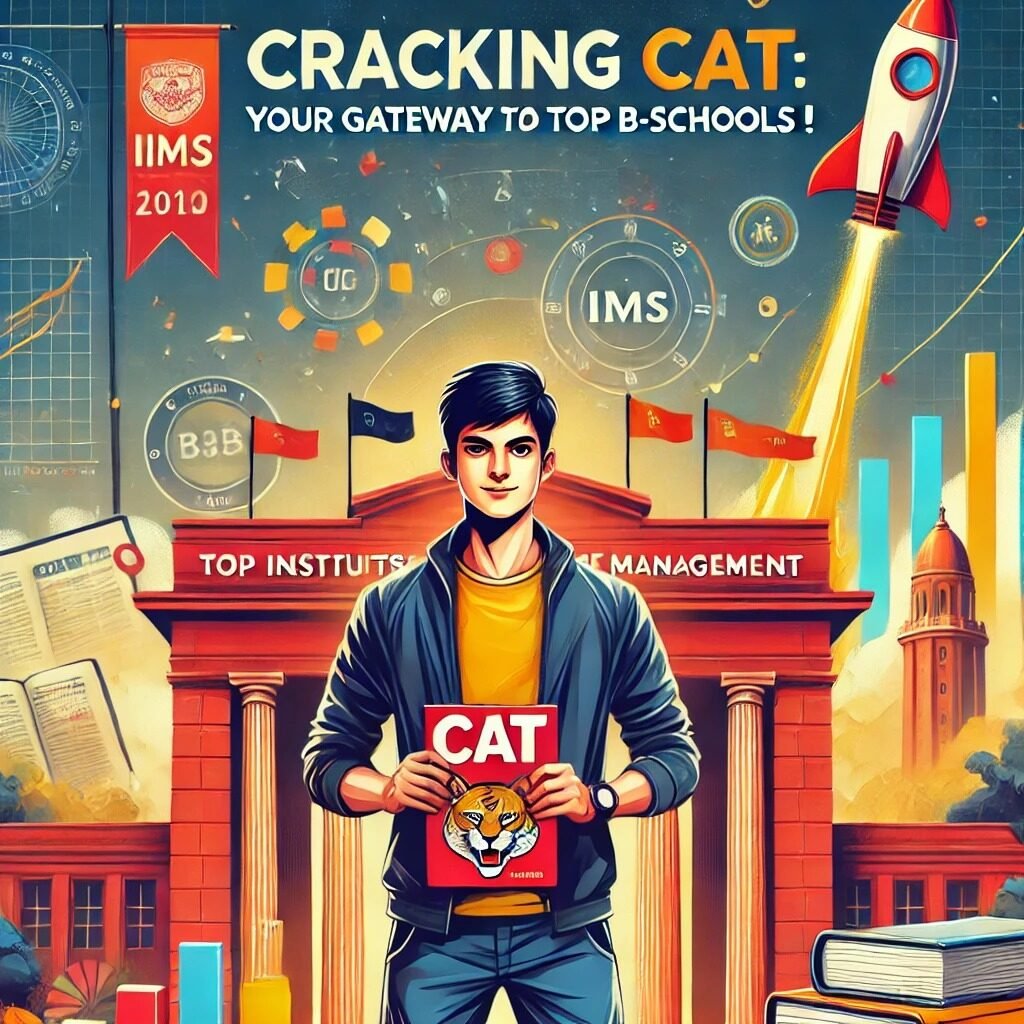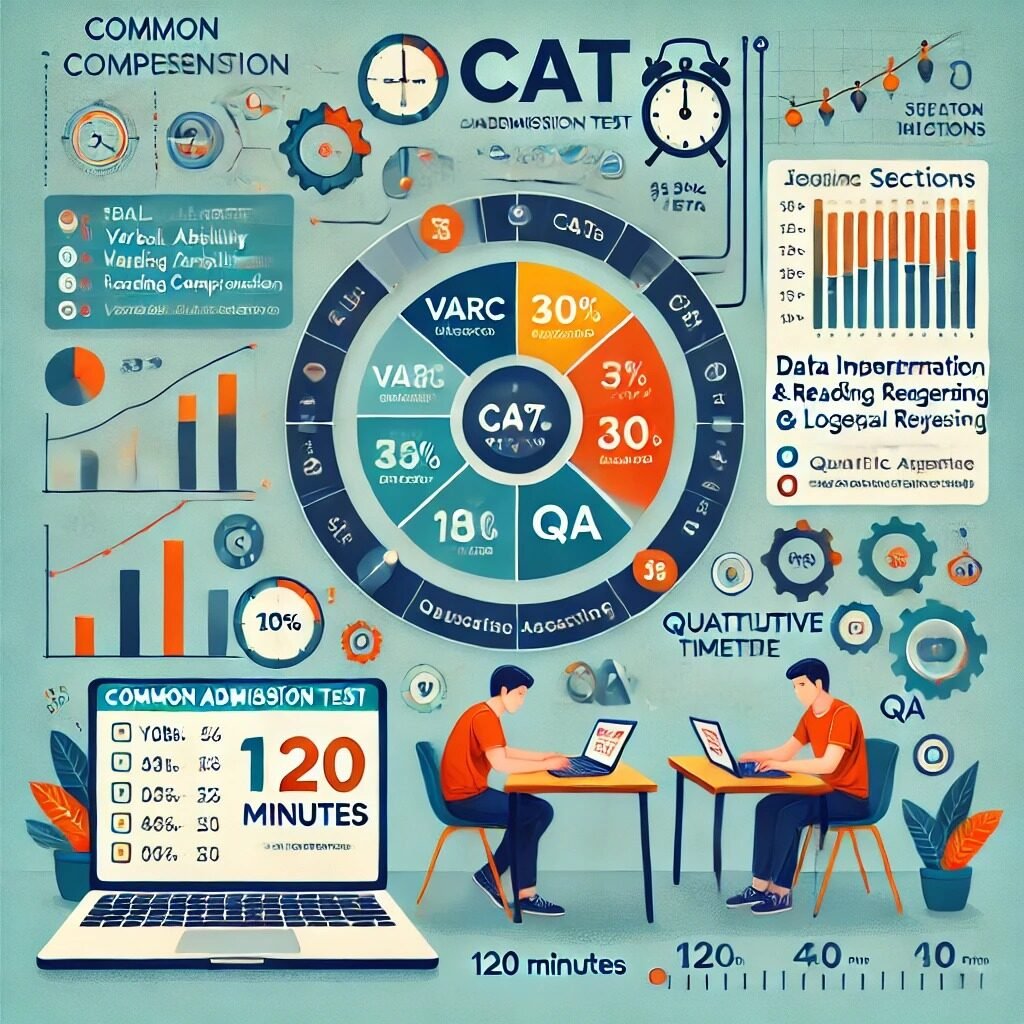- How may I help you?
- 8233970000
- 9829016449
- info@ipsedu.in
🎯 Cracking CAT: Your Gateway to Top B-Schools! 🚀📚
The Common Admission Test (CAT) is one of the most prestigious and competitive entrance exams in India for admission to top business schools, including the Indian Institutes of Management (IIMs) and other reputed institutions. Conducted annually by one of the IIMs on a rotational basis, CAT serves as a gateway to securing a seat in some of the most sought-after MBA and PGDM programs across the country.
With thousands of aspirants appearing for the exam every year, CAT has gained a reputation for being a challenging test that evaluates candidates on multiple aspects such as quantitative aptitude, verbal ability, logical reasoning, and data interpretation. A high CAT score not only increases the chances of admission to elite business schools but also opens doors to promising career opportunities in management and leadership roles.

What is CAT?
CAT is a computer-based test (CBT) conducted once a year, typically in November or December. The exam is known for its dynamic pattern and difficulty level, making it essential for candidates to have a well-structured preparation strategy. It assesses a candidate’s analytical, problem-solving, and decision-making skills, all of which are crucial for managerial roles in the corporate world.
CAT scores are accepted by more than 1,200 business schools in India, including IIMs, FMS, SPJIMR, MDI, IMT, and many others. Candidates aspiring for MBA, PGDM, and other business management programs consider CAT as their primary exam.

Eligibility Criteria
To appear for CAT, candidates must fulfill the following eligibility criteria:
- Educational Qualification: A bachelor’s degree with at least 50% marks (45% for SC/ST/PwD candidates) from a recognized university.
- Final Year Students: Candidates in their final year of graduation are also eligible to apply.
- No Age Limit: There is no upper age limit for CAT.
Exam Pattern
CAT follows a structured format with multiple-choice and non-multiple-choice (TITA – Type In The Answer) questions. The test is divided into three sections:
- Verbal Ability and Reading Comprehension (VARC)
- Data Interpretation and Logical Reasoning (DILR)
- Quantitative Aptitude (QA)
| Section | Number of Questions | Time Allotted |
|---|---|---|
| VARC | 24-26 | 40 minutes |
| DILR | 20-22 | 40 minutes |
| QA | 22-24 | 40 minutes |
- The total exam duration is 120 minutes (2 hours).
- There is a +3 mark reward for every correct answer and a -1 mark penalty for incorrect MCQs (no negative marking for TITA questions).
- Sectional time limits restrict candidates from moving between sections freely.

Syllabus Breakdown
1. Verbal Ability & Reading Comprehension (VARC)
- Reading Comprehension
- Para Jumbles
- Summary-based questions
- Sentence Completion
- Para Completion
- Critical Reasoning
2. Data Interpretation & Logical Reasoning (DILR)
- Graph-based Interpretation (Bar, Pie, Line Graphs)
- Tables and Caselets
- Puzzles and Arrangements
- Blood Relations
- Syllogisms
- Logical Deductions
3. Quantitative Aptitude (QA)
- Arithmetic (Percentages, Ratio, Time-Speed-Distance, Profit-Loss)
- Algebra (Equations, Inequalities, Functions)
- Geometry (Mensuration, Coordinate Geometry)
- Number System (Factors, Divisibility, LCM & HCF)
- Probability & Permutation-Combinations
Preparation Strategy
Cracking CAT requires a combination of strategy, practice, and time management. Here’s how you can ace the exam:
1. Understand the Exam Pattern
- Go through previous years’ question papers to analyze trends.
- Get familiar with difficulty levels and types of questions.
2. Build a Strong Foundation
- Focus on concept clarity before jumping into problem-solving.
- Strengthen basic mathematical and reasoning skills.
3. Time Management & Speed Enhancement
- Practice with mock tests and sectional tests.
- Learn shortcut techniques for calculations.
4. Reading & Vocabulary Building
- Read newspapers like The Hindu, The Economic Times.
- Enhance vocabulary through word lists and flashcards.
5. Mock Tests & Analysis
- Attempt full-length CAT mock tests.
- Analyze mistakes and work on weak areas.
Top Colleges Accepting CAT Scores
- Indian Institutes of Management (IIMs) – Ahmedabad, Bangalore, Calcutta, Lucknow, Indore, Kozhikode, etc.
- Faculty of Management Studies (FMS), Delhi
- SP Jain Institute of Management and Research (SPJIMR), Mumbai
- Management Development Institute (MDI), Gurgaon
- Institute of Management Technology (IMT), Ghaziabad
- Xavier Institute of Management (XIMB), Bhubaneswar
- Indian Institute of Foreign Trade (IIFT), Delhi/Kolkata
- T.A. Pai Management Institute (TAPMI), Manipal
CAT Score vs Percentile
CAT scores are converted into percentiles to determine a candidate’s ranking. Here’s an approximate score-to-percentile conversion:
| Score Range | Expected Percentile |
| 100-110 | 99+%ile |
| 85-100 | 95-98%ile |
| 70-85 | 90-94%ile |
| 50-70 | 80-89%ile |
Registration Process
- Visit the official CAT website.
- Fill in personal, academic, and work experience details.
- Upload photograph and signature.
- Pay the application fee (₹2,400 for General, ₹1,200 for SC/ST/PwD).
- Choose preferred exam centers.
Exam Day Guidelines
- Carry CAT Admit Card and a valid ID proof.
- Reach the center 90 minutes before the exam.
- Do not carry electronic gadgets or stationery items.
- Follow all COVID-19 safety protocols (if applicable).
Post-CAT Selection Process
Clearing CAT is just the first step; the final selection process involves:
- Written Ability Test (WAT)
- Group Discussion (GD) / Group Exercise (GE)
- Personal Interview (PI)
Each institute has its own weightage criteria for CAT score, academics, work experience, and other parameters.
Conclusion
CAT is undoubtedly a highly competitive exam, but with dedication, strategic preparation, and perseverance, one can achieve excellent results. Whether you aim for IIMs or other top B-schools, cracking CAT can be your stepping stone to a successful management career.
For aspirants, it’s important to stay consistent, practice rigorously, and maintain confidence throughout the journey. Success in CAT not only opens doors to top MBA programs but also lays the foundation for a prosperous professional future!





